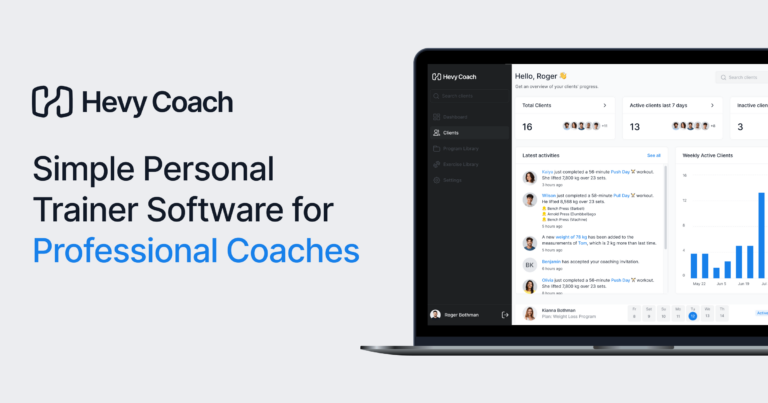In the ever-changing landscape of personal training services, pricing the workout plans you provide for clients can be a significant challenge.
As a personal trainer, you must price workout plans reasonably to attract clients but also fairly to get compensated for your hard work. Striking a balance between affordability and profitability is critical.
Plus, you must consider other important things like your competition and how your clients would perceive you and your services based on your rates. For example, pricing an exercise plan too low can make people think you’re not that good of a personal trainer.
Read on to learn how much to charge by looking at pricing strategies, market research, and more.
How Much to Charge for a Workout Plan
Proper pricing requires understanding your value as a trainer, considering certain factors (plan depth, duration, customization, etc.), and using strategies like tiered pricing, package deals, and a subscription model. Market research and competitor analysis can also help you determine how much to charge for workout programs.
Workout Program Pricing: Factors to Consider (+Examples)
Like personal training services, you must consider several important factors when pricing your workout plans. Among the factors to consider you have:
- The overall depth of the workout plan – is it nuanced, and does it include information on progression, effort, exercise selection, making tweaks on the go, etc.?
- Its duration – how long is the plan? Four, eight, twelve weeks, or even longer?
- Is it customized or a pre-made PDF? Do you have to answer questions to create an exercise program tailored to your client, or do you only provide general guidelines?

Try Hevy Coach
Intuitive personal trainer software, with a world class experience for your clients.
30 day free trial, no credit card required
Also, similar to personal training, the trainer’s reputation, qualifications, and experience play a role. For example, an established coach with an impressive track record can command higher prices, whereas someone yet to make a name for themselves in the industry would start with modest prices to attract clients.
Example #1
Take the Superior Muscle Growth bundle offered by Jay from AWorkoutRoutine. The package costs $99, but you can often get it at a 50 percent discount.
This one isn’t as expensive because it is more of an online course than a customized exercise plan. In other words, these PDF files are available for clients, and their creator doesn’t have to do ongoing coaching to generate revenue.
Example #2
In contrast to the above bundle, we have the custom workout program from BuiltWithScience. It costs $209, which is considerably more expensive, so why is that the case?
For one, the product comes with a fitness audit, which means the creator has to communicate with each person who makes a purchase to determine their starting point: fitness level, body composition, behaviors, etc.
According to the information on the sales page, each client gets a fully customized workout plan based on body type and goals. In other words, these aren’t pre-made PDFs where clients have to figure things out for themselves.

Determining Your Value as a Personal Trainer
Your value is similar to a price tag. It doesn’t just convey the monetary cost of what you offer but also hints at your expertise, knowledge, credentials, and special skills.
Take high-priced products like designer bags as an example. Have you ever wondered how something so simple can cost so much? Sure, the craftsmanship, quality of materials used, and design matter. However, something that plays an even bigger role is the brand’s reputation.
If people perceive a brand as valuable, they are more likely to overpay for simple items that don’t cost much to produce.
Similarly, personal trainers with the right qualifications, years of experience, and an impressive track record are perceived as more valuable and can charge more money.
With the above information in mind, let’s say that you charge $60 per session as a personal trainer. One simple way to price your workout plans is to see how long it takes to create each and include any associated monetary costs.
For example, if it takes 90 minutes to create a nuanced, 12-week plan and you need to use a paid program or access paid resources, the price could be $90+. This is a fair way to price the workout programs you create because you’re paid based on the time and effort you put in and the value your client gets.
If the plan is more nuanced, it would take longer to produce, provide more value, and cost more. In contrast, if the routine is more basic, it wouldn’t be as valuable, it would take less time to create, and it would cost less.
It’s worth noting that your ‘price tag’ isn’t static but subject to change. Just as products can grow in value over time, gaining experience, building your reputation, and earning more impressive qualifications allow you to make more money.
Because of that, it is crucial to continue educating yourself and find new ways to provide superior service to your clients. You can read more about the topic here.
Before moving on, check out Hevy Coach––our all-in-one platform for online coaches and personal trainers. Keep track of your clients, write and deliver workout plans, make adjustments on the go, and answer their questions, all from a single dashboard.
Pricing Strategies for Workout Plans
There are several pricing strategies personal trainers can use. Pick the one that makes the most sense for you.
1. Tiered Pricing
This is perhaps the most popular pricing structure, especially for courses, memberships, etc.
The idea is to offer multiple versions of the same product at different prices instead of only having one offer. Doing so can help you attract more clients and earn extra money from upsells.
For example:
- Basic: an 8-week training plan
- Standard: an 8-week training plan with ongoing support
- Premium: an 8-week training plan with ongoing support and a nutritional plan
Some of your clients might start with the basic package and later decide to get the standard or premium option.
2. Package Deals
As the name suggests, package deals involve bundling several things to make your offer more alluring. It works great for online personal training, but you can make it work even if you only want to sell exercise programs.
The idea is to come up with several services or products, determine the price of each, and provide special offers to people who purchase everything together.
For example:
- An 8-week workout plan with ongoing support – $149
- Setting up your nutrition eBook – $49
- Supplements guide – $19
- Motivation & Habits eBook – $29
All of these would be valued at $246, but you can offer everything for half the price.
3. Subscription Models
Subscription models will be your best option if you become an online personal trainer. However, you can apply the same principles to workout plans and earn more recurring revenue.
With the model, clients pay a recurring fee, typically monthly, to gain access to workout plans.
4. Freemium Model
This strategy involves offering a basic version of your services for free (or at a heavy discount) and charging for additional features, ongoing support, etc.
For example, you can create basic four-week plans for free to get people interested and then offer the following at an extra cost:
- Tweaks to the workout plan
- Ongoing support and accountability
- Extend the program to 8-12 weeks or longer
5. Pay What You Want Pricing
This is a lesser-known pricing structure that can bring surprisingly good results. It works like value-based pricing, but instead of setting the price, you give clients the freedom to choose how much to pay for your workout plans.
You can see the model in action here.
It’s worth noting that many people will likely pay the minimum to gain access to your product, so it’s best to use this strategy only for digital products, where no ongoing work is required.
A Look at 4, 8, 12, and 16-Week Personal Training Plans
4-Week Personal Training Program Cost
A four-week plan is great for jumpstarting the fitness journey of a client, helping them get a quick win (e.g., lose five pounds), and hopefully convincing them to consider your services or products again.
A good price for a four-week plan is typically between $30 and $60, depending on its depth.
8-Week Personal Training Program Cost
An eight-week training program is longer and allows clients to make more significant progress toward their goals. Since the plan is longer, it allows for more in-depth guidance and the addition of extras, such as chat support, progress tracking, and ongoing adjustments.
A good price for an eight-week plan is generally between $60 and $100.
12-Week Personal Training Program Cost
A 12-week plan is the standard duration and the minimum some online coaches require clients to commit to.
This is where clients can see noticeable results (especially for fat loss), and such duration will almost always need ongoing support to keep the client on the right path.
A good price for a 12-week plan is between $90 and $150, but it could be even more expensive, depending on the extras you offer (e.g., chat support, progress monitoring, and meal planning).
16-Week Personal Training Program Cost
A 16-week plan is identical to a 12-week only––it’s pretty much more of the same. Four extra weeks of support means your client can see better results, and this is typically the duration of a standard cutting phase for someone to get to beach-ready conditioning.
A good price for a 16-week plan is between $120 and $200.
The Role of Market Research in Pricing
Understanding the market is vital for setting the right product and service prices. Here are a few suggestions for how to go about it:
1. Look at Your Competitors
Whether you offer online fitness coaching or personal training at a local gym, you must know how much others charge for the same service.
For example, if others are pricing their fitness plans between $100 and 200, it would make sense to do the same unless you offer significantly more value than everyone else.
If you work with clients in person, begin your research on Google with the keyword “workout plans + your city/town” to see who your competitors are, what they offer, and how much they charge.
In contrast, if you offer online personal training, you can use keywords like “workout plans to build muscle,” “workout plans to lose weight,” “workout plans to get stronger,” or similar and examine competitors from all over the world.
2. Study Your Target Market
Next, consider your ideal client, and understand their ability and willingness to pay for fitness plans. For example, if your target market is college-aged people, know that they might not be able to spend that much.
In contrast, if your plans involve quicker workouts that require little to no equipment and your primary targets are busy professionals, you could create more detailed plans and charge extra.
3. Conduct Surveys
Conducting surveys online or in person can be a powerful way to gauge how much a prospective client is willing to pay for exercise programs and other services.

For example, if you’ve followed our advice from previous articles to build a presence online, you can send a survey to your email list and hopefully get some valuable insight.
4. Ask People in Person
The next straightforward way to decide how much to charge for exercise plans is to gather people from the gym you work at and ask them.
Encourage a discussion and ask people about their opinion on the matter to gain some valuable insight and see things from their perspective.
Of course, asking clients how much to charge them can be a double-edged sword. Encourage an honest and open discussion that benefits you and them.
Finally, Adjust Your Prices Over Time
As with in-person training sessions, there is no rule against price changes. Experiment with your pricing to see how it affects client retention (especially if you use a subscription model), refund rates, and overall satisfaction.
For example, if you’re just starting with exercise plans, offer them at a trial price for a limited time or to a limited number of clients to gather initial feedback. You can then adjust your prices before officially launching your service to your entire audience.
Similarly, run pricing experiments where you offer similar plans to different segments of your market (or audience). Doing so can provide insight into price elasticity and help you identify the optimal price for your products.
This generally works better for online personal training because the risk of conflicts is far smaller. In contrast, offering the same product or service at different prices at the gym could get people talking and wondering why they are paying more or less than others.

Try Hevy Coach
Intuitive personal trainer software, with a world class experience for your clients.
30 day free trial, no credit card required
When to Increase Prices
Here are four scenarios where it makes sense to increase your prices:
- You’ve earned a new certification. Earning credentials suggests that you’re willing to invest in yourself to expand your knowledge and expertise. As such, you can provide a superior service and charge more.
- You’ve gotten some good testimonials. Did some previous clients leave glowing reviews of your exercise plans or service? Display these on your website and social media as social proof and leverage them to charge more.
- Business is booming. Do you have more clients than you can handle? A thriving business indicates that people are happy with your plans, which means you can bump the price slightly.
- The cost of living has gone up. Even if none of the above are true, it still makes sense to increase your prices every 12-18 months, given the increasing cost of living/
How Often to Increase Prices
There isn’t a one-shoe-fits-all answer to how frequently you should adjust your prices, as numerous factors play a role––including how established you are, whether you have a stable stream of clients, and how your prices compare to the competition.
That said, it doesn’t hurt to review your prices once every 9 to 12 months to see if there is an opportunity to increase your rates.
How to Adjust Your Prices
First, don’t increase or decrease your prices by a considerable amount. Adjust them by 10 to 20 percent at a time and monitor how the changes affect sales:
- Does your conversion rate go up, down, or stay the same?
- Do you record more or fewer sales a month?
- If clients pay a subscription, do your retention rates suffer?
- Do you notice people demanding more from you since the price increase?
Also, when increasing your prices, notify your regular clients in advance or give them at least one exercise plan at your current rates before the increase takes effect.
You should strive to retain your current clients, especially low-maintenance ones, before worrying about getting new ones.
Conclusion
Whether you’re a certified personal trainer, a fitness instructor, or an online coach, selling training plans can be highly profitable. But as you can see, deciding how much to charge can be tricky––there isn’t a single solution that works great in all situations.
Because of that, we urge you to approach the process with an open mind and be ready to make adjustments based on client feedback. It will take some trial and error, but any personal training business goes through that.
Before you go, check out Hevy Coach, our all-in-one platform for personal trainers and coaches. Write programs for your clients, monitor their progress and adherence, answer their questions, and make adjustments, all from a single dashboard.




